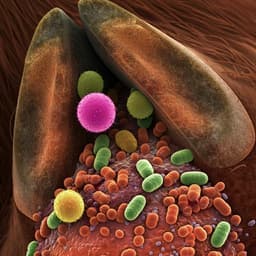
Agriculture
Rotating and stacking genes can improve crop resistance durability while potentially selecting highly virulent pathogen strains
R. Crété, R. N. Pires, et al.
This groundbreaking research by Rémi Crété, Rodrigo Neto Pires, Martin J. Barbetti, and Michael Renton explores the intricate relationship between crop cultivars and fungal pathogens. It presents a model that predicts how different rotation strategies can influence pathogen virulence and the longevity of crop resistance, revealing both the potential for prolonged disease suppression and the risk of creating highly virulent strains.
Playback language: English
Introduction
In agriculture, managing pathogen populations and disease severity is crucial for reliable crop protection. Effective strategies must consider both epidemiological dynamics (efficiency of control) and evolutionary dynamics (durability of control). Modern, intensive agricultural systems, while boosting productivity, often lead to unintended consequences, such as more severe and harder-to-control disease epidemics. This is partly due to reduced plant genetic and physiological diversity, creating homogeneous cropping systems that disrupt natural plant-pathogen co-evolution. The rapid evolution of crop pathogens to overcome host resistance is a significant concern, given the time and resource-intensive nature of developing resistant varieties.
Common disease control methods include pesticide application, tillage, resistant cultivars, sowing periods, crop rotations, and cultivar mixtures. While deploying resistant cultivars is widely used, its effectiveness is limited by pathogen adaptation if the same resistance is repeatedly used. This leads to resistance breakdown, the emergence of new pathogen pathotypes, and shifts in pathogen virulence diversity, as seen with pathogens like *Leptosphaeria maculans*, *Sclerotinia sclerotiorum*, *Hyaloperonospora brassicae*, *Albugo candida*, *Neopseudocercosporella capsellae*, and *Alternaria* spp. This necessitates developing and deploying strategies that target resistance durability and epidemiological control to prevent or delay the evolution of virulence and resistance breakdown.
The accumulation of virulence genes in pathogen genotypes, creating ‘super-virulent strains’, is a key concern. This is exacerbated by limited infection sites, leading to competition between pathogen strains. The rate of resistance breakdown varies geographically, highlighting regional differences in selective pressures. The simultaneous failure of two major resistance genes in oilseed rape in 2012 in South Australia exemplifies this risk.
Mechanistic models are vital for integrating disease processes and assessing crop management practices before implementation. Successful strategies should both limit the selection of virulent strains and reduce population sizes. While models exist for various pests and pathogens, many focus on resistance to chemical pesticides rather than the evolution of virulence. Recent models incorporate evolutionary dynamics but often assume non-sexual reproduction, overlooking the importance of sexual recombination. Complex models, while realistic, often suffer from high parameter sensitivity. This study aims to develop a more general, less complex model to investigate the long-term effects of resistant cultivar rotation strategies on pathogen virulence evolution and resistance durability.
Literature Review
Existing literature extensively documents the challenges of managing crop diseases, particularly the evolution of pathogen virulence to overcome host resistance. Studies highlight the breakdown of single resistance genes in various plant-pathogen systems, such as *Leptosphaeria maculans* in oilseed rape (canola) and other Brassicaceae pathogens. The impact of intensive agricultural practices on pathogen evolution has also been explored, emphasizing the need for durable resistance strategies. Several models have been developed to simulate plant disease dynamics and evolution, but most lack the comprehensive integration of epidemiological and evolutionary factors crucial for understanding long-term resistance durability. Many focus on chemical resistance, neglecting the complexities of pathogen virulence evolution, particularly when sexual recombination is involved. While sophisticated models capture detailed processes, their complexity can hinder their applicability and generalizability. The current research identified a gap in existing models: a simple yet robust model that considers both epidemiological and evolutionary dynamics within a polycyclic disease system, including the critical element of sexual recombination, for a wider range of crops and pathogens.
Methodology
This study developed a spatially implicit model to simulate the population and evolutionary dynamics of pathogen strains interacting with resistant crop cultivars over successive years. The model assumes one cultivar per year, with a field divided into a finite number (*m*) of spatial units (potential infection sites). Each year, pathogen spores are released from crop residues, infecting plants based on strain abundance and cultivar interactions. During the non-cropping season, strains recombine sexually in the crop residue. The model utilizes stochastic processes for spore release and infections.
The model was parameterized for a specific scenario with four resistance genes and four virulence genes. Each virulence gene in a pathogen strain independently reduces its fitness, quantified by δi = δnviri, where nviri is the number of virulence alleles and δ (0 < δ ≤ 1) is a model parameter. Four rotation strategies were compared: (S1) no rotation; (S2) rotation every year; (S3) rotation every 5 years; and (S4) yearly rotation with two stacked resistance genes.
The model dynamics are divided into two phases: parasitic activity (cropping season) and dormancy (non-cropping season). During the parasitic phase, spores are released and infections occur, apportioned among strains based on interactions with the cultivar. The interaction factor β(i,c) defines the reproduction rate of strain *i* on cultivar *c*. It's 1 for strains overcoming cultivar resistance and ε (0 < ε < 1) otherwise, reflecting reduced growth rate for avirulent strains. Each strain also has a fitness penalty, δi. The total number of infections follows a binomial distribution, while infections for each strain are multinomial. During dormancy, sexual recombination is simulated, generating new genotypes. Genotype frequencies are updated, and a multinomial distribution is used to determine the number of each strain after recombination.
The model uses Poisson, binomial, and multinomial distributions to model the stochasticity of spore release, infection, and recombination. A baseline scenario (Case 1) and four additional cases were explored (Cases 2–5) by varying model parameters: initial virulence allele frequency (Init.freq), fitness penalty (δ), and growth rate modifier for non-virulent strains (ε). These different cases were used to determine the influence of these parameters on pathogen evolution and disease control in different resistant cultivar rotation strategies.
The model was implemented using the R programming language.
Key Findings
Simulation results under baseline parameters (Case 1) showed that crop cultivar rotations significantly reduced total pathogen levels compared to no rotation (S1). No rotation led to rapid selection of the perfectly matched virulent strain. Yearly rotation (S2) maintained low infection levels, although all virulence genes were quickly selected, leading to a super-virulent strain. Five-year rotation (S3) resulted in infection peaks before cultivar change, with similar super-virulent strain selection. Stacked gene rotation (S4) eradicated the disease after 5 years.
Varying model parameters significantly impacted results. Increasing the initial virulence allele frequency (Case 2) resulted in higher early infection peaks for all strategies and clearly visible infections in all rotation strategies after 25 years. The 5-year rotation showed the highest infection levels after 25 years. Increasing the fitness penalty (reducing δ, Case 3) generally decreased infection levels and led to disease eradication in all rotation strategies, except no rotation (S1). Even though virulence genes reached high frequencies, the disease was eradicated. Increasing ε (Case 4) resulted in only small changes in infection rates, but virulence allele frequencies were pushed to zero over time; eradication of the disease occurred within 25 years.
Increasing ε (Case 5) led to results similar to the baseline scenario (Case 1), but with slower virulence selection and slightly higher infection levels. In summary, the efficacy of rotation strategies was highly sensitive to parameter values, such as the initial frequency of virulence alleles, the fitness penalty associated with virulence, and the relative growth of non-virulent strains on resistant cultivars. The best strategy depended on the specific parameter combination. While stacked resistance offered advantages in the baseline scenario, longer rotation cycles proved better under high initial virulence allele frequencies.
Discussion
The model demonstrates the complex interplay between rotation strategies, pathogen fitness, initial conditions, and the ability of avirulent strains to reproduce on resistant cultivars. The selection of super-virulent strains is a clear potential drawback of rotation, even if the rotation strategy successfully controls the disease in the short term. While simulations show complete eradication of virulence under certain conditions, in reality, mutation and spatial dispersal would likely prevent this. Rotation strategies significantly improve the longevity of resistance, but the efficacy of rotation depends greatly on the specific pathosystem and initial conditions, especially the initial frequency of virulence alleles in the pathogen population. The model underscores the need to consider the entire spectrum of fitness parameters and pathogen dynamics to make informed decisions on resistant cultivar deployment strategies. Combining rotation with other crop management practices becomes essential to manage both the short and long-term effects of pathogen evolution.
Conclusion
This study presents a novel, parsimonious model for evaluating the long-term effects of resistant cultivar rotation strategies on pathogen virulence evolution. The model highlights the significant impact of initial conditions and parameter values on the efficacy and durability of these strategies. While rotation significantly delays the build-up of damaging pathogen populations, the selection of super-virulent strains remains a potential downside. The model's simplicity and generalizability make it a valuable tool for researchers and agricultural practitioners to optimize disease management strategies and contribute towards sustainable agriculture. Future work should focus on incorporating spatial dynamics, more complex resistance traits, and ongoing mutation to enhance model realism.
Limitations
The model simplifies several aspects of real-world plant-pathogen interactions. It is spatially implicit, neglecting spatial structure in pathogen populations or cultivar deployment. While the parameter *m* (total potential lesion sites) serves as a surrogate, it does not fully capture the complexity of spatial dynamics. The model also considers only four resistance genes with major effects, ignoring potential minor resistance traits or the possibility of more genes. It does not explicitly account for ongoing mutation, implying that allele extinction is possible. While mutation is not deemed a significant limitation in this study, it could be added for future investigations. Finally, the model assumes that population dynamics depend on previous seasons' population size, which is not always the case, especially in environmentally sensitive situations.
Related Publications
Explore these studies to deepen your understanding of the subject.







